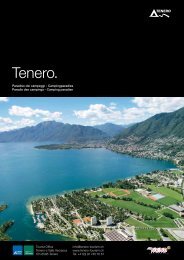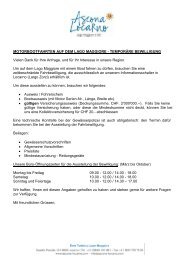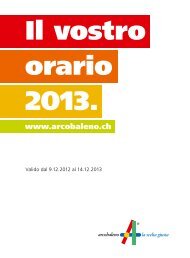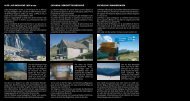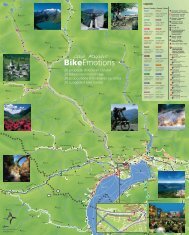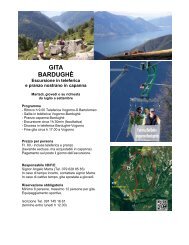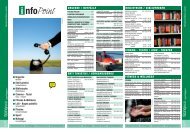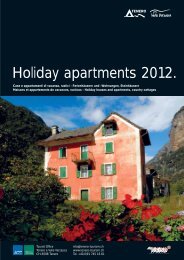Sentiero arte prospetto 2012.pmd - Tenero e valle Verzasca
Sentiero arte prospetto 2012.pmd - Tenero e valle Verzasca
Sentiero arte prospetto 2012.pmd - Tenero e valle Verzasca
Create successful ePaper yourself
Turn your PDF publications into a flip-book with our unique Google optimized e-Paper software.
Un sentiero per l’<strong>arte</strong>.<br />
Ein Wanderweg für die Kunst<br />
A footpath for art<br />
Tourist Office<br />
<strong>Tenero</strong> e Valle <strong>Verzasca</strong><br />
CH-6598 <strong>Tenero</strong><br />
info@tenero-tourism.ch<br />
www.tenero-tourism.ch<br />
Tel. +41(0)91 745 16 61
La Valle <strong>Verzasca</strong> presenta numerosi motivi di attrazione<br />
dal punto di vista ambientale, naturale e culturale. Con la<br />
realizzazione del progetto “Un <strong>Sentiero</strong> per l’Arte”,<br />
promosso in collaborazione tra l’Ente Turistico di <strong>Tenero</strong><br />
e Valle <strong>Verzasca</strong> e la Società Pittori, Scultori e Architetti<br />
Svizzeri sezione Ticino, si è intravisto un nuovo ed originale<br />
modo di valorizzare il territorio attraverso un’offerta non<br />
solo indirizzata agli amanti della natura e dell’escursionismo<br />
ma anche agli appassionati d’<strong>arte</strong>. “Un <strong>Sentiero</strong> per l’Arte”<br />
è uno spazio espositivo permanente in cui l’<strong>arte</strong><br />
contemporanea dialoga con la natura. È anche un’offerta<br />
turistica e culturale nuova, un modo singolare di proporre<br />
al visitatore un percorso nel quale il paesaggio è tutto da<br />
scoprire, da contemplare e d’ammirare.<br />
Das <strong>Verzasca</strong>tal bietet in Bezug auf Umwelt, Natur und<br />
Kultur bereits zahlreiche Sehenswürdigkeiten an. Mit der<br />
Realisierung des Projektes “Ein Wanderweg für die Kunst”,<br />
das in Zusammenarbeit zwischen dem Verkehrsverein<br />
<strong>Tenero</strong> und <strong>Verzasca</strong>tal und der Tessiner Sektion der<br />
Gesellschaft Schweizer Maler, Bildhauer und Architekten<br />
entstand, hat man auf ganz neue und originelle Weise<br />
versucht, das Gebiet aufzuwerten. Denn der “Wanderweg<br />
für die Kunst” richtet sich nicht nur an Naturliebhaber und<br />
Wanderer, sondern auch an Kunstliebhaber. “Ein<br />
Wanderweg für die Kunst” ist eine Dauerausstellung, in der<br />
die Gegenwartskunst in einen Dialog mit der Natur tritt.<br />
Es handelt sich um ein neues touristisches und kulturelles<br />
Angebot, das dem Besucher in einer einzigartigen Weise die<br />
Gelegenheit gibt, mittels einer Wanderung die Landschaft<br />
neu zu entdecken, zu betrachten und zu bewundern.<br />
The Valley <strong>Verzasca</strong> already offers numerous<br />
environmental, natural and cultural attractions. With the<br />
realization of the project “A Footpath for Art”promoted<br />
by the <strong>Tenero</strong> and <strong>Verzasca</strong> Valley Tourist Office ETTVV<br />
in collaboration with the Ticino section of the Society of<br />
Painters, Sculptors and Architects of Switzerland there is<br />
since 1997 an original offer seen as a means of interesting<br />
not only the walker and friend of the natural environment<br />
but the art lover as well. “A Footpath for Art” is a<br />
permanent exhibition where contemporary art can converse<br />
with nature. It is a new cultural, tourist proposal and a<br />
unique way to offer the visitor a walk where everything in<br />
the landscape is to be discovered, contemplated and<br />
admired.
Un sentiero di <strong>arte</strong> e natura<br />
Ein Wanderweg der Kunst und Natur<br />
A footpath for art and nature<br />
È il significato del simposio (promosso dalla SPSAS e<br />
dall’ETTVV, su un’ispirazione dello scultore Giorgio Scarmi,<br />
formalizzata in questo scritto) che alcuni artisti hanno deciso<br />
di organizzare, da Lavertezzo a Brione, lungo un tronco del<br />
<strong>Sentiero</strong>ne che risale la <strong>Verzasca</strong> e che attraversa molti luoghi<br />
della memoria <strong>valle</strong>rana più antica. L’operazione artistica<br />
denominata “Un sentiero per l’<strong>arte</strong>” si distingue dalle mostre<br />
all’aperto di tipo tradizionale per il suo carattere permanente.<br />
Le opere sono infatti destinate a rimanere nella natura, sono<br />
state pensate e costruite ben sapendo che il tempo, il clima e<br />
l’uomo ne potranno sempre modificare gli aspetti originari,<br />
forse fino alla totale distruzione. È con questa consapevolezza<br />
che un gruppo di artisti si è riunito in <strong>valle</strong>, ognuno ha scelto<br />
un luogo e ha elaborato un progetto.<br />
Von Lavertezzo bis Brione führt der “Wanderweg für die<br />
Kunst”, für dessen Realisierung sich eine Reihe von<br />
Künstlern in einem Symposium entschieden haben<br />
(gefördert durch SPSAS und ETTVV und nach einer Idee<br />
des Bildhauers Giorgio Scarmi). Genauer gesagt verläuft<br />
der Weg auf einem Abschnitt des berühmten “<strong>Sentiero</strong>ne”,<br />
der sich durch das ganze Tal und somit durch viele<br />
geschichtsträchtige Orte zieht. Das Projekt, bekannt als<br />
“Ein Wanderweg für die Kunst”, unterscheidet sich durch<br />
seine Dauerhaftigkeit von traditionellen Ausstellungen im<br />
Freien. Die Werke sind nämlich dazu bestimmt, in der Natur<br />
zu verbleiben; sie wurden schon im Bewusstsein geschaffen,<br />
dass Zeit, Wetter und Mensch deren ursprüngliches Aussehen<br />
später verändern können, vielleicht sogar bis zur totalen<br />
Zerstörung. Mit diesem Bewusstsein ist eine Gruppe von<br />
Künstlern ins Tal gekommen, jeder hat einen Ort<br />
ausgewählt und sein eigenes Projekt erarbeitet.<br />
From Lavertezzo to Brione, along a section of the main<br />
walk known as the “<strong>Sentiero</strong>ne” that follows the <strong>Verzasca</strong><br />
through many places renowned among the <strong>valle</strong>y people<br />
for their antiquity, a group of artists in symposium<br />
(promoted by the ETTVV and SPSAS on the inspiration<br />
of the sculptor Giorgio Scarmi), decided to organize a<br />
footpath for art and nature. The operation known as “Un<br />
<strong>Sentiero</strong> per l’Arte” is distinguishable from more traditional
exhibitions in the open by its permanent character. The<br />
works, destined to remain in the natural environment, are<br />
in fact constructed in the full knowledge that time, climate<br />
and man can always modify their original appearance,<br />
perhaps even to the point of total destruction. It was with<br />
this clearly in mind that a group of artists met in the <strong>valle</strong>y,<br />
each chose a point and worked out a project.<br />
Alcuni passi per un sentiero<br />
Einige Schritte entlang eines Weges<br />
A few steps on a walk<br />
Riccardo Carazzetti<br />
Un sentiero che sale, tra il bosco ed il fiume. Su quello<br />
stesso sentiero che l’uomo preistorico ha inciso nel fianco<br />
del monte quando si spingeva nella <strong>valle</strong> e ne colonizzava<br />
i poggi, adesso cammina un artista che pensa ad un segno<br />
discreto come testimonianza di un transito (quello suo)<br />
e di memoria. Un sentiero ed un fiume: segni del<br />
transeunte, di ciò che passa e va, ma anche della ciclicità<br />
e dell’eterno ritorno, di acque e persone, mai le stesse<br />
eppure in fondo sempre uguali, come le stagioni, anno<br />
dopo anno. Gli opposti convivono da sempre,<br />
armoniosamente, in questa contiguità di natura e di<br />
simboli: là dove tutto si perde e si trasforma ogni<br />
momento, tutto sembra anche di una continuità senza<br />
fine, segno di perenne rinascita, e quindi anche di eterna<br />
rigenerazione. Per la prima volta nella storia del suo<br />
genere, l’uomo del XX secolo ha sentito, con sgomento,<br />
che quella lunga catena potrebbe di colpo spezzarsi, che<br />
quel naturale equilibrio è oggi fortemente minacciato.<br />
Artisti, di provenienze e tendenze diverse, hanno<br />
ripercorso questo sentiero e hanno voluto lasciare un<br />
segno del loro passaggio: un intervento, minimo talora,<br />
che inviti a una lettura attenta e discreta dell’elemento di<br />
natura; più plastico e monumentale tal’altra, in sintonia<br />
con la forza primordiale del paesaggio circostante.<br />
Ein Weg, der zwischen Wald und Fluss ansteigt: Auf<br />
demselben Weg, der von prähistorischen Menschen in der<br />
Flanke des Berges angelegt wurde, als diese in das Tal<br />
eindrangen und dessen Hügel besiedelten, geht heute ein<br />
Künstler, der an ein dezentes Zeichen als Zeugnis des eigenen
Vorbeiziehens und der Erinnerung denkt. Ein Weg und ein<br />
Fluss: flüchtige Zeichen von etwas, das kommt und geht, aber<br />
auch Zeichen des zyklischen Ablaufes und der ewigen<br />
Wiederkehr, von Gewässern und Menschen, die niemals<br />
dieselben und dennoch im Grunde immer die gleichen sind,<br />
wie die Jahreszeiten, Jahr für Jahr. Die Gegensätze bestehen<br />
seit jeher harmonisch nebeneinander, in dieser Berührung<br />
zwischen Natur und Symbolen: dort wo sich alles verliert und<br />
jeden Moment wandelt, erscheint alles wie eine Kontinuität<br />
ohne Ende, wie ein Zeichen immerwährender Wiedergeburt,<br />
ewiger Erneuerung. Zum ersten Mal in seiner Geschichte hat<br />
der Mensch des 20. Jahrhunderts mit Bestürzung festgestellt,<br />
dass diese lange Kette plötzlich brechen könnte, dass dieses<br />
natürliche Gleichgewicht heute stark bedroht ist. Künstler,<br />
verschiedener Herkunft und unterschiedlichen<br />
Kunstrichtungen verpflichtet, sind diesen Weg nachgegangen<br />
und wollten ein Zeichen ihres Vorbeigehens hinterlassen:<br />
Eingriffe, manchmal ganz kleine, die zu einer aufmerksamen<br />
und diskreten Lesart der Natur einladen, mal plastische, mal<br />
monumentale Eingriffe, die in Einklang mit der<br />
ursprünglichen Kraft der natürlichen Umgebung stehen.<br />
A footpath that climbs between wood and river. On that<br />
same footpath that prehistoric man cut on the side of the<br />
mountain when he pushed into the <strong>valle</strong>y and colonized the<br />
hills, an artist now walks thinking of a discreet sign as a<br />
testimony of passage (the artist’s) and of memory. A path<br />
and a river: fleeting signs, of what passes and goes, but also<br />
of the cyclical and of the eternal return of water and people,<br />
never the same but basically always alike, like the seasons<br />
year after year. Opposites living harmoniously in this<br />
circumstance of nature and symbolism: there where<br />
everything is lost and transformed every moment, all things<br />
seem a continuation without end, a sign of perennial rebirth,<br />
and also therefore of eternal regeneration. For the first time<br />
in the story of our kind 20th century humanity has felt, with<br />
dismay, that this long chain of events might in one blow<br />
shatter and that this natural equilibrium is today forcefully<br />
threatened. Many artists from different origins and<br />
tendencies, walked this path and chose to leave a sign of their<br />
passing through: an intervention, sometimes minimal that<br />
discreetly invites an attentive reading of a natural element,<br />
at others more plastic and monumental, in tune with the<br />
primordial strength of the surrounding landscape.<br />
Claudio Guarda
Colonna <strong>Verzasca</strong><br />
Cemento armato, pietre, acciaio<br />
Stahlbeton, Steine, Stahl<br />
Concrete, stone, steel
Con l’eloquenza propria delle interpretazioni di segno<br />
forte, l’opera riassume il pensiero di fondo sotteso all’intera<br />
operazione che ha condotto a realizzare il “<strong>Sentiero</strong> per<br />
l’<strong>arte</strong>”: volontà di testimonianza, volontà di rimembranza,<br />
suffragio nei confronti della grandezza della natura. La<br />
colonna, di per sé icona universale della commemorazione,<br />
nella sua spoglia definizione formale è anche elemento<br />
peculiare del linguaggio dell’<strong>arte</strong> concreta ed espressione<br />
dell’incontro di architettura e scultura. I materiali rustici<br />
che definiscono la superficie vogliono essere un richiamo<br />
alla specificità culturale e paesaggistica del luogo.<br />
Mit einer interpretationsstarken Aussage fasst dieses Werk<br />
eigentlich die Grundgedanken zusammen, die zur<br />
Verwirklichung des “Wanderweges für die Kunst” geführt<br />
haben: der Wille, Zeugnis abzulegen, der Wille,<br />
Erinnerungen zu wecken, und der Wille, sich mit der Grösse<br />
der Natur auseinanderzusetzen. Die Säule, die an und für<br />
sich bereits eine universale Ikone der Erinnerung ist, hat in<br />
ihrer bloss formalen Definition aber auch einen<br />
einzigartigen Stellenwert in der konkreten Kunstsprache als<br />
Schnittpunkt zwischen Architektur und Skulptur. Die<br />
groben Materialien auf der Oberfläche des Kunstwerkes<br />
wollen an die kulturellen und landschaftlichen<br />
Eigentümlichkeiten des Standortes erinnern.<br />
With eloquent affirmation this powerful work captures the<br />
underlying thoughts that guided the entire process leading<br />
to the realisation of the “Footpath for Art”: the will to<br />
testify, to remember, to confront the immensity of nature.<br />
The column, itself a universal icon of commemoration,<br />
stripped to its formal definition, holds a unique place in<br />
the concrete language of art at the interface between<br />
sculpture and architecture. The rough structural surface<br />
materials serve to recall the simple rural culture of the<br />
region.<br />
Josef Briechle - Tiengen/Hochrhein (D) 1939<br />
Scultore, pittore / Bildhauer, Maler / Sculptor, painter
Occhi nell’acqua<br />
Visori in acciaio inox<br />
Detailbetragrachter aus Edelstahl<br />
Stainless steel viewing tubes
In uno scenario naturale di grandiosa bellezza, l’isolamento<br />
di un dettaglio minimo quale invito all’ascolto di massima<br />
disponibilità. Una finalità poetica comunicata attraverso il<br />
mezzo gentile dello stupore, della curiosità e della scoperta<br />
stimolate dal “gioco”. Fisico di formazione, Eigenmann<br />
arriva all’espressione artistica quale sbocco della<br />
sperimentazione scientifica e viene a proporre una versione<br />
originale dell’<strong>arte</strong> fenomenologica e sensoriale legata ai<br />
filoni concretisti e cinetici. L’acqua, esclusiva materia<br />
d’indagine della sua ricerca, vale quale emblema di una<br />
situazione di inarrestabile transitorietà.<br />
Die Isolierung eines Details lädt mitten in einer prachtvollen<br />
Landschaft zu einer maximalen Bewusstseinskonzentration<br />
ein. Es handelt sich um ein poetisches Ziel, das über ein<br />
sanftes “Spiel” angeregt und durch Verwunderung, Neugier<br />
und Entdeckung erreicht wird. Der zum Physiker<br />
ausgebildete Eigenmann gelangt zu seiner Kunstform als<br />
Ableger wissenschaftlicher Versuche, indem er eine originelle<br />
Deutung der Kunst vornimmt, die sich mit Natur<br />
beschäftigt. Wasser - ein Material, mit dem er sich in seinen<br />
Arbeiten ausschliesslich befasst - gilt als Symbol einer nie<br />
endenden Übergangssituation.<br />
In an astounding natural environment, the isolation of a<br />
minimal detail, which attunes our awareness to its highest<br />
pitch. A poetic finality communicated by the gentle means<br />
of the curious wonder of discovery stimulated by “play”.<br />
Physicist by training, Eigenmann comes to artistic<br />
expression as an offshoot of scientific experimentation,<br />
proposing an original vision of art dealing with natural<br />
phenomena, concrete and kinetic in tendency. Water the<br />
only material of investigation of his research is also<br />
emblematic of transience.<br />
Helmut Eigenmann - Milano (I) 1951<br />
Fisico e artista / Physiker und Künstler / Physicist and Artist
20 . 05 . 97<br />
Granito inciso, smalto<br />
Gravierter Granit, Email<br />
Incised granite, paint
Dopo avere maturato una lunga esperienza della scultura<br />
intesa come problema di potenza plastica affrontato con la<br />
pratica diretta sul materiale, Tedoldi - che ha nella pietra il<br />
suo materiale di elezione - ha intrecciato la sua ricerca, da<br />
sempre pertinente all’astrazione, con ragioni di ordine<br />
concettuale, riducendo la corporeità dell’oggetto a presenza<br />
segnaletica di spazio. Come qui, dove su massi rocciosi -<br />
espressione naturale di plasticità - l’artista si limita ad<br />
incidere un tracciato che nella sua continuità, ricostruibile<br />
idealmente, rimanda ad una proiezione volumetrica<br />
avvolgente il fruitore dell’opera.<br />
Der Künstler hat nach einer langjährigen Erfahrung in der<br />
Bildhauerei, die er als direktes plastisches Einwirkungsproblem<br />
auf das vorliegende Material verstand, in seiner<br />
immer schon abstrakt orientierten Arbeit aufgrund<br />
konzeptioneller Überlegungen die Gegenständlichkeit<br />
seiner Kunstwerke - Stein war seit jeher sein<br />
Lieblingsmaterial - auf eine Zeichensetzung im Raum<br />
reduziert. So wie hier, wo sich Tedoldi auf Felsblöcken -<br />
natürlicher Ausdruck der Plastizität - auf die Eingravierung<br />
eines Zeichens beschränkt, das in seiner imaginär<br />
rekonstruierbaren Kontinuität auf einen volumetrischen<br />
Entwurf verweist, der den Betrachter des Werkes<br />
miteinbezieht.<br />
After developing over many years experience a sculptural<br />
language understood as a problem of facing the plastic<br />
potential of materials directly, Tedoldi - for whom stone is<br />
the preferred medium - has woven his research, always<br />
pertaining to the abstract, conceptually directed, towards<br />
reducing the volume of the object to a presence described<br />
in space by a mark. As in this instance where on the bedrock<br />
masses - a natural expression of plasticity - the artist limits<br />
himself to incising a tracing which in its continuity, ideally<br />
reconstructed, makes a volumetric projection which<br />
envelops the person experiencing the work.<br />
Piero Tedoldi - Adliswil (CH) 1945<br />
Scultore / Bildhauer / Sculptor
Frania (in memoria di Pioda)<br />
Materiali e oggetti di recupero<br />
Rezyklierte Materialen und Gegenstände<br />
Recycled building materials
Prova di acrobazia costruttiva (le strutture sono<br />
praticamente autoportanti, così che l’albero, dentro<br />
all’involucro, resti libero), l’opera materializza la fantasia<br />
infantile del bosco incantato. L’efficacia comunicativa è<br />
piena, grazie al potere di coinvolgimento della meraviglia,<br />
emozione dominante generata da Frania. Esempio di <strong>arte</strong><br />
“contaminata” dalla vita - esperienze e materiali della quale<br />
vengono indiscriminatamente assunti a formare la sostanza<br />
artistica - ha nella ricerca di dialogo la sua principale<br />
motivazione. L’intenzione dedicatoria (il titolo riprende il<br />
nome di una località sommersa dal lago artificiale creato<br />
con la diga che sbarra la Valle <strong>Verzasca</strong>) stempera il colore<br />
fiabesco dell’opera con una nota di struggente realismo.<br />
Das Werk ist der Versuch einer baulichen Akrobatik (die<br />
Strukturen sind praktisch selbsttragend, so dass der innen<br />
stehende Baum nicht berührt wird) und materialisiert die<br />
kindliche Phantasie eines Zauberwaldes. Dank einer grossen<br />
kommunikativen Wirkkraft löst Frania das Eingebunden-<br />
Sein in ein Wunder als dominierende Empfindung aus. Es<br />
ist ein Beispiel einer durch Leben “kontaminierten” Kunst<br />
(Erfahrungen und Materialien, die unterschiedslos das<br />
künstlerische Wesen bestimmen), welche die Suche nach dem<br />
Dialog als Hauptmotiv hat. Die Widmung löst die<br />
märchenhafte Farbe des Werkes durch einen Bezug zur<br />
Realität wieder auf (der Titel stammt vom Namen einer<br />
Ortschaft, die durch den Bau des Stausees im <strong>Verzasca</strong>tal<br />
überflutet wurde).<br />
A test of acrobatic construction (the structures are practically<br />
self standing so the trees inside are free) the work materializes<br />
the enchanted wood of infant fantasy. The power of fully<br />
effective communication makes involvement in the marvel<br />
the dominant emotion generated by Frania. An example of<br />
art “contaminated” by life - experiences and materials of<br />
which have been indiscriminately gathered to form the<br />
artistic substance - has in the search for dialogue its principal<br />
motivation. The dedication (the title takes the name of a<br />
locality submerged by the artificial lake created by the dam<br />
that blocks the <strong>Verzasca</strong> <strong>valle</strong>y) dissolves the fairy tale colours<br />
of the work with a note of all consuming realism.<br />
Gerardo Wuthier - Locarno (CH) 1966<br />
Scenografo, pittore / Bühnenbildner, Maler<br />
Stage designer, painter
Tracce di un Mandala<br />
Pietre, cemento<br />
Steine, Zement<br />
Stones, cement
Come nei suoi gioielli-scultura (o nelle sue sculturegioiello),<br />
Hanny Bürgin procede anche qui per<br />
“assemblaggio” di materiali trovati. Posto così direttamente<br />
sulla via, questa sorta di mosaico povero si apparenta ad<br />
antichi resti di pavimentazioni: come quelli, umile ed<br />
emozionante. A malapena rilevabile dal resto della pista,<br />
sembra proiettarsi in una dimensione temporale che<br />
appartiene tanto ad un remoto passato quanto ad un remoto<br />
futuro. Costruita da una forza centripeta, la figura si scioglie<br />
progressivamente per effetto di una forza di segno opposto;<br />
il senso di incompiuto, vuoi di infinito, suggerito dal<br />
rarefarsi dei poli estremi rimanda ad una condizione di<br />
perenne migrazione.<br />
Wie bei ihrem Skulpturen-Schmuck verfährt Hanny Bürgin<br />
auch hier nach dem Prinzip des Zusammenfügens<br />
vorgefundener Materialien. Direkt auf dem Weg liegend<br />
erinnert dieses simple Mosaik an die Pflastersteine alter<br />
Saumpfade; wie jene zugleich bescheiden und<br />
emotionsgeladen. Da das Werk kaum vom Rest des Weges<br />
unterscheidbar ist, scheint es in eine andere zeitliche<br />
Dimension zu führen, die sowohl einer entfernten<br />
Vergangenheit als auch einer entfernten Zukunft angehört.<br />
Von einem Mittelpunkt nach aussen strebend zerfliesst das<br />
Gebilde allmählich - wie durch die Wirkung einer<br />
entgegengesetzten Kraft; so entsteht durch das<br />
Verschwinden extremer Pole der Schein des<br />
Unvollständigen, des Unendlichen, der auf einen Zustand<br />
ewiger Migration verweist.<br />
As in her sculptured jewelry (or in her jewelry sculptures)<br />
Hanny Bürgin also begins here with an assemblage of found<br />
materials. Placed directly on the path, this rough mosaic<br />
suggests the remains of an ancient road, humble and elusive.<br />
Hardly discernible from the rest of the path it seems to<br />
project into another dimension of time in the remote past<br />
or future. Spreading outwards from a central stone the form<br />
melts progressively as if caused to do so by an opposing<br />
force. The seemingly incomplete, void of the infinite,<br />
scattering to the extreme poles, a condition of perennial<br />
migration.<br />
Hanny Bürgin - Basel-Land (CH) 1945<br />
Oggetti ornamentali, scultura / Schmuckkunst, Skulpturen<br />
Art jewelry, sculpture
Qui c’è, o qui c’era<br />
Fusione in ottone da matrice scavata nell’osso di seppia<br />
Messingguss aus der Kavität einer Sepiaschale<br />
Brass cast in a cuttlebone mold
L’atto di marcare il territorio attraverso l’impianto di una<br />
microscultura in funzione di termine va inteso quale ideale<br />
proseguimento di una pratica atavica di esperienza<br />
dell’ambiente. Costruita su valori simbolici (la figura in<br />
rilievo dei piccoli piedi sottintende, rispetto alla sua matrice<br />
in cavo, una complementarità al vuoto ed è metafora di<br />
restituzione di memoria) l’opera vale come dichiarazione,<br />
carica di sofferenza e di amore, di radicamento dell’uomo<br />
in un luogo preciso. Un pensiero di marca antropologica<br />
fonda dunque un’<strong>arte</strong> alla quale si torna a conferire la<br />
capacità di dare risposte, anche passando per le strade della<br />
speculazione ermetica.<br />
Der Vorgang, ein Gelände durch die Einrichtung einer<br />
Mikroskulptur abzustecken, wird als Fortführung einer<br />
primitiven Praxis der Umwelterfahrung verstanden.<br />
Basierend auf symbolischen Werten (das Relief der kleinen<br />
Füsse ist komplementär zum Hohlraum der Giessform und<br />
somit eine Metapher für die Wiedergabe der Erinnerung)<br />
ist das Werk ein von Leid und Liebe gekennzeichnetes<br />
Bekenntnis für die Verwurzelung eines Menschen an einem<br />
bestimmten Ort. Anthropologisch geprägte Gedanken<br />
gründen demnach eine Kunst, der man wieder die Fähigkeit<br />
zuschreibt, Antworten zu liefern, auch wenn sie Wege<br />
dunkler Spekulation durchläuft.<br />
The act of marking the territory by the insertion of a micro<br />
sculpture in functional terms is intended as following in<br />
concept an atavistic practice in the experience of the<br />
environment. Built on symbolic values (in relation to their<br />
concave mold, the small feet in relief suggest a complement<br />
to the void, a metaphor for the restoration of memory) the<br />
work stands as a declaration of the toil and love of human<br />
beings rooted in a precise place. Thoughts of an<br />
anthropological mark therefore anchor the art work, which<br />
is able in return to respond, even if passing by way of<br />
obscure speculation.<br />
Franco Lafranca - Cavergno (CH) 1953<br />
Artista concettuale / Konzeptkünstler / Conceptual artist
Piede dei druidi<br />
Granito della <strong>Verzasca</strong><br />
Granit aus dem <strong>Verzasca</strong>tal<br />
<strong>Verzasca</strong> granite
Le cinque stele sono idealmente collegate tra loro da un<br />
tracciato continuo formante una stella a cinque punte<br />
inserita in un cerchio e orientata al nord: ne risulta una<br />
figura esoterica, leggibile anche come rappresentazione<br />
dell’essere umano. Definito da un deciso moto ascensionale,<br />
il monumento - collocato in modo suggestivo nella zona<br />
di stacco tra l’ombra del bosco e la chiarità dello spazio<br />
aperto - allude al passaggio dalla sfera terrena a quella<br />
celeste. Raccogliendo uno dei compiti che la riflessione<br />
artistica del XX secolo ha assegnato all’<strong>arte</strong>, quello di<br />
restauratrice della unità dell’uomo, l’artista può farsi, come<br />
qui, sciamano - ascoltato o meno - e le sue opere porsi come<br />
idoli di una ritrovata primordialità.<br />
Die fünf kreisförmig aufgestellten Stelen bilden idealerweise<br />
einen fünfeckigen Stern, der gegen Norden weist: so entsteht<br />
eine esoterische Figur, die sich auch als Darstellung des<br />
Menschen deuten lässt. Die inhärente Steigungsbewegung<br />
des Werkes, das sich sehr eindrucksvoll in der<br />
Übergangszone zwischen dem Schatten des Waldes und der<br />
Helligkeit des offenen Raumes befindet, spielt auf den<br />
Übergang von der irdischen zur himmlischen Sphäre an.<br />
Denkt man an eine der Hauptaufgaben, die die Kunstkritik<br />
des 20. Jahrhunderts den Künstlern anvertraut, nämlich die<br />
Wiederherstellung der Einheit des Menschen, kann sich der<br />
Künstler, wie im vorliegenden Fall, zum Schamanen<br />
machen, der seine Werke als Vorbilder eines<br />
wiedergefundenen Ursprungs anbietet.<br />
The five stelae inserted in a circle orientated to the north<br />
are ideally linked together by the continuous tracework of<br />
a five pointed star: an esoteric figure results, which can also<br />
be read as a representation of a human being. With resolute<br />
ascending motion, the monument - located thought<br />
provokingly in a zone of transition between the shadow of<br />
the wood and the light of the open field - alludes to the<br />
path from the terrestrial to the celestial sphere. Picking up<br />
on one of the duties that 20th century artistic theory has<br />
assigned to art, to restore the unity of man, the artist can<br />
make himself, as in this instance, a shaman - heard or not -<br />
and offer his work as a simulacrum of a refound<br />
primordiality.<br />
Giorgio Scarmi - Locarno (CH) 1950<br />
Scultore / Bildhauer / Sculptor
Contenitore di energia cosmica<br />
Ferro, acciaio inox<br />
Eisen, rostfreier Stahl<br />
Iron, stainless steel
La schematica struttura piramidale che individua e indica<br />
un luogo privilegiato di raccoglimento, proposto come sosta<br />
a chi percorre il sentiero, mostra stretta attinenza con la<br />
ricerca pittorica di marca esistenziale sviluppata da Lüönd.<br />
Al pari che nel mezzo espressivo abituale, anche qui ribadita<br />
è la centralità dell’uomo, considerato nella sua duplice e<br />
conflittuale sostanza fatta di materia e spirito. Messo a<br />
confronto con una situazione operativa eccezionale,<br />
marcata dall’immersione in un’entità totalizzante come è<br />
la natura, l’artista inclina ad un messaggio di equilibrio e di<br />
rigenerazione.<br />
Die schematische Pyramidenstruktur, die auf einen<br />
aussergewöhnlichen Ort energetischer Konzentration<br />
verweist (und als Rastplatz auf dem Wanderweg<br />
vorgeschlagen wird), zeigt eine enge Beziehung zu der<br />
existentiellen Suche im malerischen Werk von Lüönd. So<br />
wie in seinen Bildern wird auch hier die zentrale Stellung<br />
des Menschen hervorgehoben, und zwar in seiner<br />
zweifachen Seinsweise, als ein Wesen, das aus Körper und<br />
Seele besteht. Durch den besonderen, vollkommen in die<br />
Natur eintauchenden Standort gelangt der Künstler zu einer<br />
Botschaft der Ausgeglichenheit und geistigen Erneuerung.<br />
The schematic pyramidal structure which singles out and<br />
indicates a privileged place for energy regeneration,<br />
proposed as a resting place for those walking the path,<br />
demonstrates close affinity to the pictorial research of the<br />
“existential mark” developed by Lüönd. In parity with his<br />
usual expressive language, here also man stands at the<br />
centre, considered in his double and conflicting substance<br />
of spirit and matter. Presented with an exceptional working<br />
situation of total immersion in nature, the artist leans<br />
towards a message of equilibrium and regeneration.<br />
Antonio Lüönd - Lugano (CH) 1947<br />
Pittore / Maler / Painter
Pyrosione<br />
Beola del posto, marmo<br />
Örtlicher Gneis, Marmor<br />
Local gneiss, marble
Opera “da capomastro” nel senso alto del termine, il lavoro<br />
interpreta nei materiali e nelle regole dell’architettura spontanea<br />
del luogo la forma aulica e carica di storia della piramide. La<br />
scultura vede qui ripristinata interamente la sua valenza<br />
originaria di monumento, legittimandola con la rinnovata<br />
centralità accordata al materiale: la pietra diventa, secondo un<br />
assunto di autenticità, il termine su cui si confronta l’artista,<br />
che arriva a prospettarsi quale protagonista di imprese<br />
ciclopiche, sorta di risposta ai picchi elevati dalla natura. Il<br />
titolo, contrazione di Pyramide e Erosion, avverte della<br />
sostanza enigmatica dell’opera: la sua poliedrica risonanza<br />
sembra accennare anche a finalità catartiche.<br />
Als ein wahrhaftiges “Maurermeisterwerk” interpretiert diese<br />
Arbeit die erhabene und geschichtsträchtige Form der<br />
Pyramide sowohl durch die verwendeten einheimischen<br />
Materialien als auch durch die ortsüblichen Regeln der<br />
Architektur. Die Skulptur erreicht hier eine ursprüngliche<br />
Monumentalität, indem das Material ganz im Mittelpunkt<br />
steht. Der Stein wird praktisch zu einem authentischen Begriff,<br />
mit dem sich der Künstler auseinandersetzt. Er macht sich zum<br />
Hauptdarsteller einer gigantischen Tat, quasi als Antwort auf<br />
die umliegenden Berggipfel. Der Titel, eine Verschmelzung<br />
von Pyramide und Erosion, unterstreicht den rätselhaften<br />
Charakter des Werkes: dessen vielflächige Resonanz scheint<br />
auch auf kathartische Absichten hinzuweisen.<br />
Work of a “master craftsman” in its true sense, the piece<br />
materially and architecturally describes spontaneously from<br />
the site, the courtly and historically laden form of a pyramid.<br />
The sculpture purged completely of all but its valence as a<br />
monument is legitimised by the renewed central position given<br />
to materials. Accordingly the stone becomes authenticated as<br />
the terms which confront the artist who as protagonist in this<br />
cyclopean endeavor, responds to the challenges of nature. The<br />
title a contraction of Pyramide and Erosion draws attention<br />
to the enigmatic substance of the work: its polyhedral<br />
resonance seems to suggest a cathartic finality.<br />
Eric Kappeller - St. Gallen (CH) 1951<br />
Scultore / Bildhauer / Sculptor
Fantatopo 2<br />
Terra, sassi, piante, acqua<br />
Erde, Steine, Pflanzen, Wasser<br />
Earth, stones, plants, water
Determinante appare il modello della tradizione orientale<br />
dell’<strong>arte</strong> del giardino, specie riguardo all’aspetto<br />
contemplativo e alla ricerca di un risultato armonico. La ben<br />
maggiore visibilità dell’<strong>arte</strong>fice, il quale manipola i materiali<br />
del proprio “quadro” forzando il contrasto tra artificiale e<br />
naturale, ne costituisce invece l’elemento differenziatore.<br />
Sorta di “opera totale” e di “opera aperta”, si apparenta ad<br />
esperienze dell’avanguardia quali il Merzbau di Schwitters,<br />
al tempo stesso rinnovando l’immagine e il mito del “Paradiso<br />
terrestre”, insopprimibile anelito dell’uomo. Percepibile<br />
un’impronta sacrale, di concerto con la dominante figura<br />
della spirale, simbolo di rinnovamento e di crescita.<br />
Entscheidend erscheint hier die orientalische Tradition der<br />
G<strong>arte</strong>nkunst, insbesondere deren kontemplativer Aspekt<br />
und deren Suche nach Harmonie. Andererseits schafft der<br />
Künstler, der die Materialien des eigenen “Bildes”<br />
manipuliert, indem er den Kontrast zwischen Kunst und<br />
Natur verstärkt, ein divergierendes Element. Dies ergibt<br />
eine Art “offenes Gesamtwerk”, das sich an die Erfahrungen<br />
der Avantgarde wie Schwitters’ Merzbau anlehnt, während<br />
gleichzeitig der Mythos des “irdischen Paradieses” erneuert<br />
wird, nach dem sich die Menschen unaufhaltsam sehnen.<br />
Durch die dominante geometrische Figur der Spirale, ein<br />
Symbol der Erneuerung und des Wachstums, ergibt sich eine<br />
sakrale Konnotation des Werkes.<br />
Seemingly determinant here is the traditional model of the<br />
oriental garden, especially regarding the contemplative aspect<br />
and the search for harmony. The major visibility of the artist<br />
in the way materials are manipulated in the “picture” forcing<br />
the contrast between the artificial and the natural, constitutes<br />
on the other hand the diverging element. A kind of “total,<br />
open, evolving work”, which is similar to experience as that<br />
of the avant-garde work the Merzbau of Schwitters, while at<br />
the same time renewing the image of the myth of the terrestrial<br />
paradise, man’s unsuppressible yearning. A thumbprint of<br />
the sacred is perceptible in the concept, with the dominant<br />
figure of the spiral, symbol of renewal and growth.<br />
Renato Tagli “Cick” - Vira Gambarogno (CH) 1956<br />
Grafico, artista ambientale / Grafiker, Landschaftkünstler<br />
Graphic designer, environmental artist
Nine events on a walk<br />
Metallo, vetro, plexiglass<br />
Metall, Glas, Plexiglas<br />
Metal, glass, plexiglass
Trionfale e poetico approdo di una ricerca concentrata sulla<br />
disciplina del numero, in particolare sulla formulazione<br />
spaziale di schemi geometrici rapportati al numero nove.<br />
Il significato dell’opera supera l’esile fisicità del tracciato<br />
(sorta di visore prospettico, frutto di estrema sintesi formale<br />
e pur aderente per analogia ai movimenti strutturali della<br />
natura) variato ma uguale nei nove punti dell’intervento,<br />
per inglobare il paesaggio in tutte le sue componenti, inclusa<br />
quella temporale richiesta dalla scoperta del percorso.<br />
Toccando terra, acqua e aria, l’opera vive di un concetto<br />
unitario di respiro cosmico. Il visibile diventa dunque un<br />
fatto immaginativo e la sostanza dell’opera d’<strong>arte</strong> si slega<br />
dalla sua entità fisica.<br />
Die von Zahlenforschungen ausgehende Arbeit -<br />
insbesondere von der räumlichen Anordnung der Zahl neun<br />
- führt zu einem triumphalen und poetischen Ergebnis. Die<br />
Bedeutung des Werkes geht weit über den leichten<br />
Charakter des Entwurfs hinaus (eine Art perspektivische<br />
Betrachtung, Resultat einer extrem formellen Synthese, in<br />
der dennoch Analogien zu strukturellen Bewegungen der<br />
Natur zu finden sind); die neun Eingriffspunkte,<br />
verschieden und doch gleich, beziehen die Landschaft in<br />
all ihren Dimensionen ein, einschliesslich der Zeit, die man<br />
für den Weg braucht. Durch die Verbindung mit Erde,<br />
Wasser und Luft erhält das Werk eine einheitliche, kosmische<br />
Grösse. Das Sichtbare erscheint wie eine Einbildung und<br />
die Substanz des Kunstwerks löst sich von ihrer Materialität.<br />
A triumphal and poetic resolution of research concentrated<br />
on the discipline of number, in particular on special<br />
formations of geometric plans reproduced from the number<br />
nine. The significance of the work exceeds the slender<br />
physical forms of the layout (a kind of prospective viewer,<br />
fruit of extreme formal synthesis while also a close fitting<br />
analogy for the moving structures of nature) varied<br />
although the same, the nine points of the intervention<br />
capture the totality of the walk in all its components<br />
including that of time, needed for the exploration of the<br />
path. Touching earth, water and air the work lives by the<br />
uniting concept of cosmic breath. The visible becomes<br />
therefore an imaginative event, its physical entity releasing<br />
the substance of the work of art.<br />
Penelope Margaret Mackworth-Praed - London (GB) 1949<br />
Scultrice / Bildhauerin / Sculptress
Spazio nello spazio, blu<br />
Legno dipinto<br />
Bemaltes Holz<br />
Painted wood
Intervento definito da marcata essenzialità e incisività. Il<br />
processo riduttivo alla base della formulazione espressiva<br />
si lega, in un rapporto di contrasto e necessità, alla grande<br />
dimensione, potenzialmente tesa all’infinito. Pur disposti<br />
secondo uno schema lineare, ossia rigido, i quattro elementi<br />
della composizione - che già per forma e colore risultano<br />
in voluta opposizione all’organicismo dell’ambiente in cui<br />
sono inseriti - creano uno spazio e danno origine ad una<br />
struttura aperta, indicatrice delle fondamentali direzionalità<br />
ed atta a stimolare una presa di coscienza del luogo naturale.<br />
Ein auf das Wesentliche konzentrierter Kunst-Eingriff:<br />
Ausgangspunkt ist ein redundanzfreier Prozess, der sich -<br />
in einem Verhältnis zwischen Notwendigkeit und Kontrast<br />
- mit einer grossen, fast schon unendlichen Dimension<br />
verbindet. Auch wenn die vier Gestaltungselemente nach<br />
einem streng linearen Schema angeordnet sind - schon<br />
wegen Form und Farbe ein gewollter Widerspruch zur sie<br />
umgebenden Natur -, erzeugen sie einen Raum und<br />
begründen eine offene Struktur, welche die vier elementaren<br />
Himmelsrichtungen anzeigt und zu einer Reflexion über<br />
die natürliche Umgebung anregt.<br />
An intervention distinguished by its marked essential<br />
incisiveness. The reductive process at the base of the<br />
expressive formis tied by necessity and contrast to the large<br />
size, potentially stretching to infinity. Placed in a rigid linear<br />
plan the four elements of the composition - which already<br />
in formation and colour are in direct contrast to the organic<br />
nature of the site where they are inserted - create a space<br />
and form an open structure indicating the fundamental<br />
directions and acting to stimulate a conscious awareness of<br />
the natural environment.<br />
Ernesto Oeschger - Basel (CH) 1931<br />
Scultore, autore di illustrazioni / Bildhauer, Installationen-<br />
Künstler / Sculptor, environmental artist
Spazio 2000<br />
Metallo, marmo<br />
Metall, Marmor<br />
Metal, marble
P<strong>arte</strong>cipe di una poetica surrealista, l’oggetto ingenera<br />
un’impressione di spaesamento, quale può derivare da una<br />
presenza inaspettata che oscilla senza soluzione tra assurdità<br />
e naturalezza, tra evidenza corporea e illusione logica.<br />
Oggetto inscenato, ossia messo in scena, sembra immerso in<br />
una luce propria, scenografica per l’appunto, che ne aumenta<br />
l’ambiguità e ne accentua il senso di confusione e<br />
contaminazione tra piano reale e piano onirico. Il soggetto<br />
della rappresentazione - uova quale simbolo di rigenerazione<br />
e rinnovamento della vita - vale come messaggio di speranza,<br />
proiettato nell’imminente nuovo millennio.<br />
Wie bei einem surrealistischen Werk erzeugt dieses Objekt<br />
eine Empfindung der Verlorenheit, die von einer<br />
unerw<strong>arte</strong>ten Präsenz stammen kann, die unentschlossen<br />
zwischen Absurdität und Natürlichkeit, zwischen<br />
materieller Evidenz und logischer Illusion hin und her<br />
schwankt. Es handelt sich um ein inszeniertes<br />
beziehungsweise in Szene gesetztes Objekt, das - wie in sein<br />
eigenes Bühnenlicht getaucht - die Zweideutigkeit steigert<br />
und den Eindruck der Verworrenheit und Überschneidung<br />
zwischen Realität und Traumwelt betont. Die verwendeten<br />
Gegenstände - Eier als Symbol der Wiedergeburt und<br />
Erneuerung des Lebens - sind eine Botschaft der Hoffnung<br />
für das bevorstehende neue Jahrtausend.<br />
Taking part in a surrealist poetry, the object engenders an<br />
impression of loss, which is derived from an unexpected<br />
presence oscillating unresolved between the natural and the<br />
absurd, between physical evidence and logical illusion. A<br />
thing posed, or put on stage, seemingly immersed in its<br />
own light. Precise scenery, which augments the ambiguity<br />
stressing the sense of confusion and contamination between<br />
the real and the dream plane. The subject of the piece - the<br />
egg a symbol of regeneration and renewal of life - is a<br />
message of hope projected towards the new millennium.<br />
Enrico Scippa - Lecce (I) 1937<br />
Scultore, pittore / Bildhauer, Maler / Sculptor, painter
Outbreak III / Outbreak II<br />
Lamiera acciaio, vegetale / Lamiera acciaio, superficie rocciosa<br />
Stahlblech und Wachstumsrhytmus / Stahlblech und Felsplatte<br />
Steel sheet and natural growth / Steel sheet and rock surface
Nel corso della sua riflessione artistica, Sandra Eades ha<br />
isolato dall’osservazione del paesaggio - di brani di esso,<br />
meglio - forme-segni, assumendoli quali personali moduli<br />
espressivi al servizio di una poetica del frammento. Un<br />
processo di astrazione lirica (piuttosto che di riduzione<br />
minimalista) riportato sulla grande scala tipica degli<br />
interventi di Land Art e che si riconduce alla ricerca<br />
dell’archetipo. Così, la chiamata in causa della natura quale<br />
agente cooperante all’opera - al quale si affida anche il<br />
compito di rimarginazione della ferita-segno - comporta<br />
un sentimento di sottomissione ad un ciclo universalistico<br />
risolutivo.<br />
Im Laufe ihrer künstlerischen Entwicklung hat Sandra<br />
Eades Form-Zeichen aus ihrer Betrachtung der Landschaft<br />
herausgearbeitet, die sie als persönliche Ausdrucksweise<br />
einer fragmentarischen Poetik verwendet. Es handelt sich<br />
eher um einen Prozess lyrischer Abstraktion als um<br />
minimalistische Reduktion, den sie auf die typisch grossen<br />
Massstäbe der Land-Art anwendet und der der Suche nach<br />
der Urform, des Archetyps, gilt. Indem natürliche Kräfte<br />
genutzt werden - und ihnen die Vernarbung der durch das<br />
Zeichen entstandenen Wunde anvertraut ist - entsteht ein<br />
Gefühl des Sich-Unterordnens unter einen universalen<br />
Lebenskreislauf.<br />
In the course of her artistic work, from her observations of<br />
landscape Sandra Eades has isolated shapes, or rather formsigns,<br />
which have become her permanent expressive<br />
modules at the service of a fragmented poetry. A process<br />
of lyrical abstraction (rather than minimalist reduction)<br />
enlarged to a scale typical of land art, which leads again to<br />
the research of the archetypal. Calling in nature’s<br />
cooperation as an operative agent - giving it the work of<br />
healing the wound-sign - creates a feeling of submission to<br />
a universal cycle.<br />
Sandra Eades - Chelmsford (GB) 1949<br />
Pittrice, land artist / Malerin, Land Artist<br />
Paintress, land artist
Natura/Tempo - Spazio/Pittura<br />
Luogo/Memoria - Spazio/Pittura<br />
Acrilico su granito / Ceramica dipinta<br />
Akryl auf Granit / Bemalte Keramik<br />
Acrylic paint on granite / Painted ceramic tile
Estremamente controllato, il duplice intervento mira alla<br />
sottolineatura dell’inarrivabile opera della natura e della<br />
millenaria relazione-confronto dell’uomo con essa. Poco<br />
importa qui l’affermazione della individualità dell’artista,<br />
il quale rivendica per sé unicamente la superstite possibilità<br />
di tracciare un segno più o meno effimero. L’opera infatti<br />
discende dall’incontro con quella tendenza attuale della<br />
ricerca artistica che individua la necessità di riportare l’uomo<br />
su di un piano di “umile compresenza” nel seno della natura.<br />
Nodo centrale di riflessione appare la dialettica tra la<br />
sostanza artificiale dell’intervento d’<strong>arte</strong> e quella naturale<br />
del contesto ambientale.<br />
Dieses doppelte Kunstwerk zielt darauf ab, das<br />
Unerreichbare naturgewordenen Seins sowie das uralte<br />
konfliktreiche Verhältnis zwischen Mensch und Natur zu<br />
unterstreichen. Die Individualität des Künstlers tritt hier<br />
vollkommen in den Hintergrund; er nimmt für sich lediglich<br />
in Anspruch, ein mehr oder weniger ephemeres Zeichen zu<br />
setzen. Das Werk entspricht tatsächlich einer gegenwärtigen<br />
Kunsttendenz, in der der Kunstschaffende sein Werk im<br />
Sinne einer “bescheidenen Koexistenz” mit der Natur<br />
versteht. Als zentrales Element erscheint hier die Dialektik<br />
zwischen dem künstlichen Wesen eines Kunstwerkes und<br />
dem natürlichen Wesen der es umgebenden Umwelt.<br />
Rigorously controlled, the double intervention aims at<br />
underlining the impossibility of competing with nature and<br />
its age-old confrontational relationship with man. The<br />
artist’s individual affirmation has little effect, here he only<br />
claims for himself the remaining possibility of tracing a<br />
more or less ephemeral sign. The work stems from a current<br />
tendency in artistic practice which singles out the necessity<br />
to return man to a level of “humble coexistence” within<br />
nature. The core of the issue appears to be the dialectic<br />
between the artificiality of an artistic intervention and its<br />
validity set in the context of the natural environment.<br />
Ivano Facchinetti - Locarno (CH) 1952<br />
Pittore / Maler / Painter
Installation<br />
Acciaio inox<br />
Edelstahl<br />
Stainless steel
A riprova di un non eludibile legame tra <strong>arte</strong> e società, la<br />
rielaborazione artistica di materiali dell’ambito industriale<br />
continua ad occupare gli scultori. La preoccupazione è<br />
quella di sovvertire dall’interno le dinamiche uniformanti<br />
e l’aridità della meccanizzazione attraverso la forza della<br />
fantasia e la messa in valore delle inedite potenzialità<br />
espressive dei materiali. Così Tschudin, trasformando<br />
l’atelier dell’artista in una sorta di officina, lavora con la<br />
lamiera, intervenendo sulle superfici in modo da mutarne<br />
lo stato anodino in uno comunicativo e ritagliandone forme<br />
allusive all’uomo e alla natura.<br />
Die künstlerische Umgestaltung von Materialien aus der<br />
Industriewelt beschäftigt die Bildhauer weiterhin als Beweis<br />
einer nicht zu umgehenden Bindung zwischen Kunst und<br />
Gesellschaft. Dahinter steckt die Idee, von innen heraus die<br />
uniforme Seinsweise und grobe Mechanik dieser Objekte<br />
aufzubrechen und durch die Kraft der Phantasie das<br />
expressive Potential der Materialien offenzulegen. So<br />
wandelt Tschudin das Künstleratelier in eine Art Werkstatt<br />
um, wo er mit Blech arbeitet. Er bearbeitet die Oberflächen<br />
in einer Art und Weise, um aus einem unbedeutenden<br />
Objekt etwas Kommunikatives zu erzeugen. Er kreiert<br />
Formen, die Mensch und Natur ähneln.<br />
As proof of the unavoidable bond between art and society,<br />
the artistic re-elaboration of material from the world of<br />
industry continues to occupy sculptors. The idea is to<br />
subvert from inside the dynamic of uniformity and arid<br />
mechanization by revealing the untapped expressive<br />
potential of the materials. So Tschudin transforms the art<br />
studio into a kind of industrial workshop and uses sheet<br />
metal, working on the surfaces in a way that changes its<br />
anodyne state into one that communicates and cuts forms<br />
that allude to nature and man.<br />
Rudolf Tschudin - Liestal (CH) 1960<br />
Scultore / Bildhauer / Sculptor
Das fliegende Ei<br />
Acciaio inox<br />
Edelstahl<br />
Stainless steel
La carica utopistica propria di tutto il lavoro di Lüthi<br />
raggiunge qui particolare evidenza, che la dimensione di<br />
stupore, frutto di un dominio delle leggi fisiche percepito<br />
piuttosto come elusione di esse, amplifica. Del resto, tra le<br />
componenti tipiche e determinanti dell’opera di Lüthi figura<br />
il ricorso alle conoscenze scientifiche e tecnologiche (specie<br />
nell’ambito delle energie): in modo diretto oppure - come in<br />
questo discoide il cui bianco rivestimento ne fa un diffusore<br />
di luce - allusivo. La corrispondenza tra uomo e natura si<br />
allarga al cosmo, tendendo ad un’unità che ridimensiona<br />
drasticamente la posizione dell’uomo. Motore dell’espressione<br />
di Lüthi è la riflessione sulla cronaca della condizione umana,<br />
ciò che ne connota l’opera d’impegno sociale.<br />
Der utopische Gehalt, der alle Arbeiten Lüthis charakterisiert,<br />
wird hier besonders deutlich; und sogar noch durch eine<br />
Reaktion des Staunens verstärkt, weil die herrschenden<br />
Naturgesetze hier wie aufgehoben erscheinen. Im übrigen<br />
wird unter den typischen Merkmalen in Lüthis Werk immer<br />
wieder der Rückgriff auf wissenschaftliche und technologische<br />
Kenntnisse deutlich (insbesondere im Energiebereich) : direkt<br />
oder - wie in diesem weissen, scheibenartigen Lichtbrecher -<br />
nur andeutungsweise. Die Beziehung zwischen Mensch und<br />
Natur öffnet sich dem Kosmos und trachtet nach einer Einheit,<br />
die den Stellenwert des Menschen drastisch verringert. Das<br />
Nachdenken über die menschlichen Lebensbedingungen<br />
treibt Lüthi in seiner sozial engagierten Kunst voran.<br />
The visionary content found in all Lüthi’s work is<br />
particularly evident here, where a measure of astonishment<br />
is amplified, the result of a dominion of physical laws seen<br />
rather as an elusion of themselves. Among the other<br />
components typical of Lüthi’s work figures the recourse<br />
to scientific knowledge and technology (especially in terms<br />
of energy): directly or, as in this discoid, where the white<br />
covering creates an - allusive - diffusion of light. The<br />
relationship between man and nature enlarged to a cosmic<br />
unit tends to drastically diminish man’s position. One area<br />
that creatively drives Lüthi, his social commitment, is<br />
shown here by his reflecting on the human condition.<br />
Steff Lüthi - Linden (CH) 1955<br />
Scultore / Bildhauer / Sculptor
Brione<br />
<strong>Verzasca</strong> 756<br />
Val Osola<br />
Piee 733<br />
P<br />
Ganne 669<br />
P<br />
P<br />
Parking<br />
Bus<br />
Restaurant<br />
Pic-nic area<br />
N<br />
Sonogno<br />
Motta 629<br />
Lunghezza<br />
Länge / Lenght<br />
4,5km<br />
Tempo di marcia<br />
Wegzeit / Time required<br />
2h30<br />
Grado di diffcoltà facile<br />
Schwierigkeitsgrad leicht<br />
Difficulty easy<br />
- luglio 2012<br />
Ganne Lavertezzo<br />
Colonna <strong>Verzasca</strong><br />
Occhi nell’acqua<br />
20 . 05 . 97<br />
Frania<br />
Tracce di un Mandala<br />
Qui c’è, o qui c’era<br />
Piedi dei druidi<br />
Contenitore di energia cosmica<br />
Pyrosione<br />
Fantatopo 2<br />
Nine events on a walk<br />
Spazio nello spazio, blu<br />
Nine events on a walk<br />
Spazio 2000<br />
Outbreak III<br />
Natura/Tempo - Spazio/Pittura<br />
Installation<br />
Outbreak II<br />
Luogo/Memoria - Spazio/Pittura<br />
Das fliegende Ei<br />
P<br />
Lavertezzo 532<br />
<strong>Tenero</strong><br />
Locarno<br />
P



